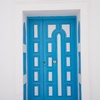Disclaimer
This entry contains information known to us from a variety of sources but may not include all the information currently available. Please be in touch if you notice any inadvertent mistakes in our presentation or have additional knowledge or sources to share. Thank you.
Archive
Synagogue Mishkan Yaakov, Zarzis, Tunisia
The small town of Zarzis, Tunisia sits 50 minutes from the island of Djerba on the coast of the Mediterranean Sea. At its height, this coastal town once held a thriving Jewish community of over one thousand members (1). Jewish life in Zarzis centers on the magnificent Mishkan Yaakov Synagogue, a meticulously restored structure that still serves the roughly 130 Jews living in the town (2).
Description
Mishkan Yaakov Synagogue
Amidst the dusty, merchant filled streets of Zarzis, sits the impressive entrance to the Mishkan Yaakov Synagogue. Multiple blue arches line the entrance to the main sanctuary. The ornately carved wooden bimah elegantly sits in the middle of the large, open sanctuary. A chandelier hangs from the tall, decorative ceiling. Colorful and intricate geometric tile adorns the walls, blanketing the room with shades of blues, whites and yellows (3). This unique synagogue has been designed in the Andalusian style, which can be seen in its use of color, decorative tiles and its combination of form and function (4). Indeed, adjacent to the sanctuary is an open courtyard lined with blue benches. The courtyard lacks any foliage, and in fact, looks more like a classroom than an outdoor space. The school attached to the synagogue meets in this indoor/outdoor location and offers their 15 students fresh air along with their lessons (2).
However, the Mishkan Yaakov Synagogue has not always been as beautiful as it is today. Built in 1905 and styled after the great synagogue in Djerba, the synagogue was burned to the ground during an arson attack in 1982 (1). The attack was thought to be a response to the Israeli incursion into Lebanon. However, the community rallied and restored the synagogue to its original glory (1). Today, in addition to its yeshiva, prayers are read every Saturday morning (1).
History of Jews in Zarzis:
The Jews who founded the community came from Djerba after Tunisia became a French Protectorate in 1881 (5). They migrated south hoping to become active in the newly founded olive oil industry (5). The numbers of Jews in Zarzis began to grow from 350 in 1905 to 802 in 1931 (5). Religiously, these Jews followed the traditions brought from Djerba. However, they did not live in a specific Jewish Quarter, though they tended to live close to one another all the same (5). The community was managed by a committee of citizens who were taken from the wealthiest Jews in the city. This committee was in charge of revenue, public spending, and maintaining relationships with the French and local Muslims (5).
During WWII, German forces passed by Zarzis, however, none of the Jews were directly affected, though some fled to the countryside to avoid allied bombs (5). After the war, the community grew even bigger than before. They were aided by Jewish relief organizations and by 1946 the Jewish population reached its peak of 1,026(5). However, tensions in the area began to rise with the establishment of the state of Israel in 1948 along with Tunisian Independence between 1952-1956 (5). As a result, local Zionist organizations were forced to outwardly curtail their activities (5). In 1952, the Jewish Agency organized for half of the town’s Jews to emigrate to Israel (5). By 1976, the Jewish population of Zarzis hovered at around 150 (5). Today, it has dropped even further, to roughly 130 (1). Jewish life in Zarzis, though small in numbers, remains large in the spirits and hearts of the Jews who choose to call the Mishkan Yaakov Synagogue home.
Sources
Notes:
1) Hyacinth Mascarenhas, “Photos of the Last Remaining Synagogues in the Muslim World,” Aish.com, November 29, 2014.
http://www.aish.com/jw/s/Photos-of-the-Last-Remaining-Synagogues-in-the-Muslim-World.html Accessed July 18,2018
2) Cnaan Liphshiz, “In Tunisia, an ancient Jewish community braves uncertain future,” The Times of Israel, September 27, 2017.
https://www.timesofisrael.com/in-tunisia-an-ancient-jewish-community-braves-uncertain-future/ Accessed July 18, 2018
3) Chrystie Sherman, “Photos of the Mishkan Yaakov Synagogue in Zarzis, Tunisia,” Diarna archive, accessed July 18, 2018.
4) Juliette Hohnen, “Andalusian Architecture: Characteristics and Features,” JulietteHohnen.com, May 2, 2017.
http://juliettehohnen.com/blog/andalusian-architecture-characteristics-and-features/ Accessed July 18,2018
5)”Zarzis,” The Museum of The Jewish People at Beit Hatfutsot , accessed July 18, 2018. https://dbs.bh.org.il/place/zarzis
Bibliography:
Hohnen, Juliette. “Andalusian Architecture: Characteristics and Features,” JulietteHohnen.com, May 2, 2017.
http://juliettehohnen.com/blog/andalusian-architecture-characteristics-and-features/ accessed July 18, 2018
Liphshiz, Cnaan. “In Tunisia, an ancient Jewish community braves uncertain future,” The Times of Israel, September 27, 2017.
https://www.timesofisrael.com/in-tunisia-an-ancient-jewish-community-braves-uncertain-future/ accessed July 18,2018
Mascarenhas, Hyacinth. “Photos of the Last Remaining Synagogues in the Muslim World,” Aish.com, November 29, 2014.
http://www.aish.com/jw/s/Photos-of-the-Last-Remaining-Synagogues-in-the-Muslim-World.html accesed July 18,2018
Sherman, Chrystie. “Photos of the Mishkan Yaakov Synagogue in Zarzis, Tunisia,” Tunisia Trip Summer 2016, Diarna archive, accessed July 18, 2018.
”Zarzis,” The Museum of The Jewish People at Beit Hatfutsot, accessed July 18, 2018. https://dbs.bh.org.il/place/zarzis accessed July 18,2018
Write up prepared by Sarah Lord, 20 July 2018.







